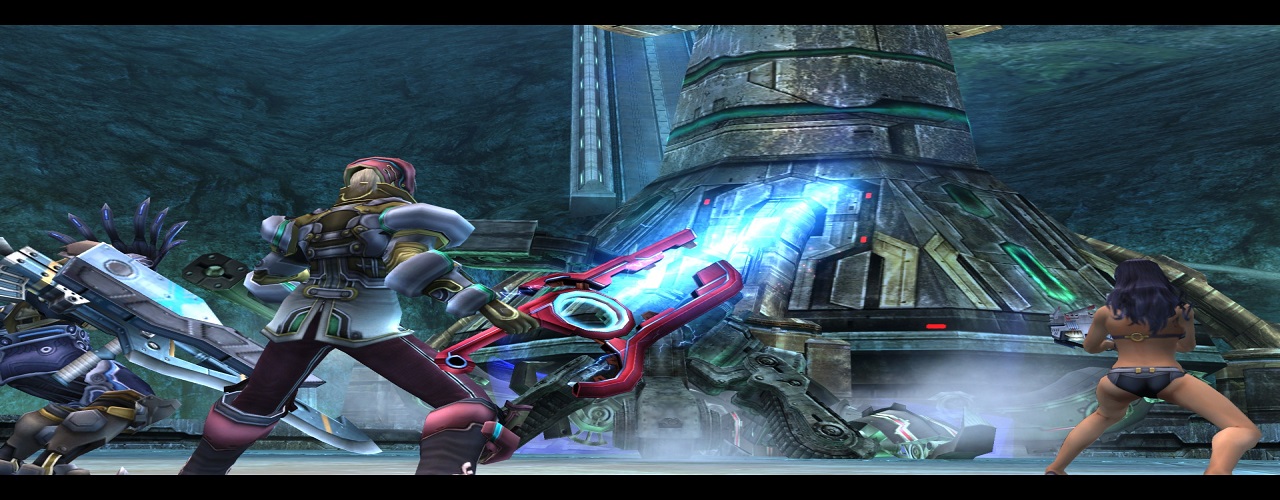Every once in a while, a game comes along that completely immerses you in its world. You think about it at work, and cancel plans with friends so you can stay in and play. You dream about it at night, and when you do see your friends, you’re constantly talking about it. The last game that had this effect on me was Xenoblade Chronicles.
Xenoblade is a JRPG for the Wii, and one of the finest games I’ve ever played. It’s nowhere near as polished as its peers, partly due to the limitations of the hardware, but it makes up for it by delivering an incredible world, a great cast of characters, and an engrossing story.
Every great story - be it a book, film or a videogame - follows the same general structure. The Hero’s Journey, or Monomyth, is a pattern of storytelling that separates stories into three acts; usually with a beginning hook, a middle plot twist, and a dramatic climax. In Xenoblade, the hook comes in about the ten hour mark, and from then on I was completely and utterly addicted.
Up to this point, the game’s narrative doesn’t stand out too much from the pack. You live on Bionis, a world inhabited solely by biological life. An invading army from Mechonis, an opposing world of only machines, swarms into your little town and kills someone who you care about, so you and a buddy take off to defeat them, swearing revenge.
The first story point has you traveling to the only other human colony on the planet to see if you might join forces. However, once you arrive, you find it’s been completely destroyed – occupied by the Mechon army. Your only hope is to go through the mines underneath the colony and launch a surprise counter-attack.
Once in the mines, you have a vision of the future thanks to the powers of your trusty magic blade, The Monado, which lets you know that your attack won’t go as planned, and that one of your allies will die in the process.
Sure enough, you square off against Xord - a giant Mechon - at the bottom of the mine. One of the colony’s last survivors, Otharon, attempts to turn the tide of battle by sacrificing himself and dropping Xord into the fiery river below. He dangles over the edge and fires his rifle into Xord’s face, dedicating his sacrifice to his fallen comrades and telling them that he’ll see them soon.
But thanks to your visions, one of your party members is able to save him. The fight isn’t over, however. As you’re escaping, Xord launches after you for one last attack. Your party mercilessly slaughters him, but as he’s taking his dying breaths, he comments about how his eyes were opened once he “became this way.” For the first time, we begin to think that maybe these Mechon are operating under the orders of some higher power - that they didn’t all begin as heartless killing machines.
Shortly after the fight, you have a very long vision of the future, which involves new characters and places, and you get a tiny glimpse of a Mechon with a person inside it. It’s a mind-blowing revelation, because for the first time, we get a clue about what the Mechon are doing with the people they steal from the colonies; they’re using them, in some kind of Matrix-like harvesting technique to produce new warriors for their army. We realize that this story might not go where we thought it was going, and our minds run wild with the possibilities.
It’s at this point where Xenoblade’s story ramps up and separates itself from the pack. If you weren’t already invested in the game before, now you’re hooked. Your party’s single-minded mission of destroying all Mechon just had a wrench thrown in it. Now you’re not sure what to believe. Your quest becomes as much about finding answers as it does about getting revenge. Your enemies have becomes slightly more empathetic, which raises the stakes for the story. You obviously hope that your party will be successful in defeating the Mechon and restoring peace to the world, but you’re also fearful that there’s something far more sinister going on, and that you may be doing more harm than good. This is just the first of several plot twists, and each one raises the stakes higher and higher until the end. Although the story’s conclusion is a bit convoluted, the ride getting there is a blast, and it all kicks off at the bottom of a mineshaft.
Every story needs a hook. You wouldn’t be happy about watching a movie where nothing happens for forty minutes [Editor’s note - The Hobbit, anyone?] , and you wouldn’t enjoy playing a game like that, either. Sometimes the hook occurs in the first ten hours, sometimes in the first ten minutes - but every great story has one; and it’s usually the moment when a game stops being just a game, and becomes a part of your life.
